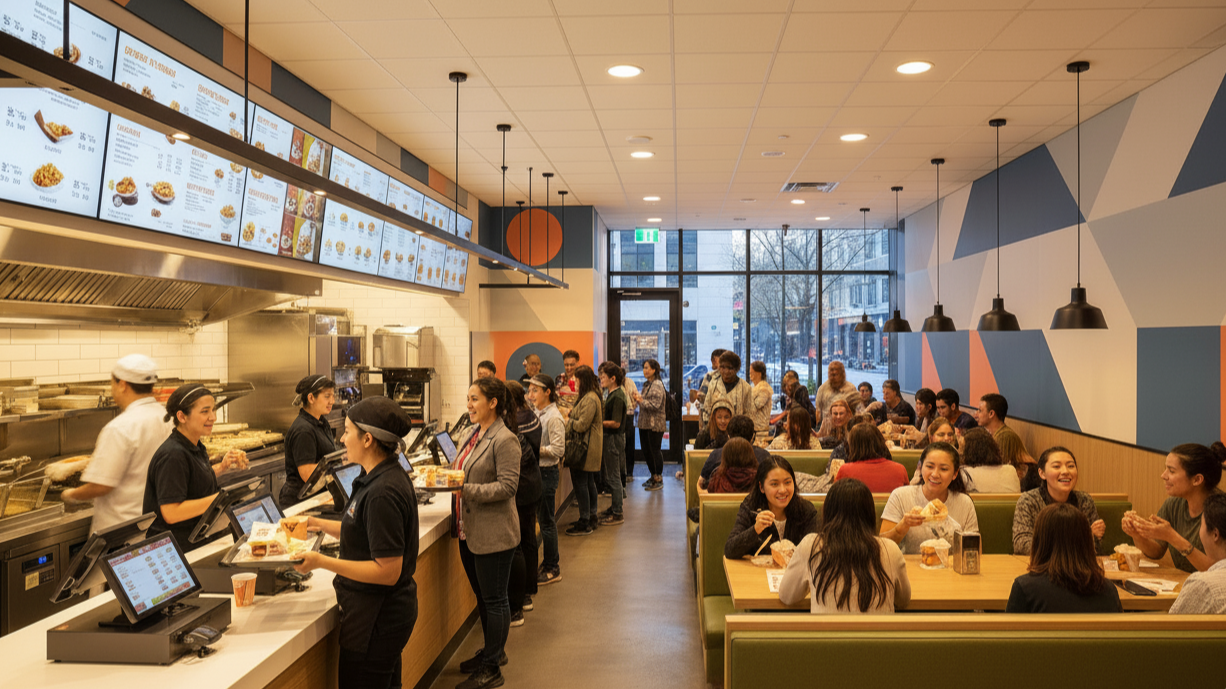
Opening a Coffee Bar: The Complete Guide for Restaurant Owners & Entrepreneurs
Coffee is more than just a drink; it’s a ritual. Every morning, millions of people line up for their lattes, cappuccinos, or cold brews. In fact, the U.S. coffee market alone is valued at over $100 billion annually (National Coffee Association), making it one of the most profitable food-and-beverage segments. But here’s the real question: if coffee is so popular, what does it take to succeed at opening a coffee bar when competition is already fierce?
For restaurant owners and aspiring entrepreneurs, coffee bars present a unique opportunity. They aren’t just businesses, they’re cultural hubs where people gather, work, relax, and connect. The challenge is creating a concept that stands out, runs efficiently, and keeps customers coming back day after day.
In this guide, you’ll learn everything you need to know to make a coffee shop business plan, from shaping your concept and designing your space to staffing, tech, and financial planning. Think of this as your complete playbook for opening a coffee bar with confidence.
Why Opening a Coffee Bar is a Great Business Idea
Starting a coffee bar isn’t just about selling drinks; it’s about tapping into one of the most resilient and growing industries. Customers are already conditioned to spend on their daily cup, which means the demand is steady.
The specialty coffee market is booming, $101.6B in 2024, projected to hit $183B by 2030. The global specialty coffee market was estimated at USD 101.6 billion in 2024 and is forecast to grow to USD 183 billion by 2030, growing at a healthy CAGR of 10.4%, affirming that coffee bars are entering a strong, expanding market.
But to make it work, you need to understand both the opportunities and the risks to make a strategic coffee shop business plan.
- Market Size & Growth
Specialty coffee has become a booming segment. Each week, more than 70% of U.S. adults enjoy coffee, cementing its spot as the nation’s most-loved beverage, and younger generations are especially drawn to unique brews, plant-based milk, and experiential cafés. This demand ensures a steady customer base.
- Cultural Shift: Coffee Shops as Community Hubs
Coffee bars aren’t just about caffeine anymore; they’re about connection. Customers seek out spaces that double as remote offices, casual meeting spots, or creative hangouts. Positioning your coffee bar as a hub makes it sticky in customers’ routines.
- Profit Potential vs. Risks
Typical net profit margins for coffee shops fall between 5%–15%, with well-managed ones hitting 15%–25%. But like any business, risks exist; poor location, weak branding, or inefficient operations can sink even a great idea. The good news: with a clear plan, your chances of success improve dramatically.
Crafting Your Coffee Bar Concept
When opening a coffee bar, your concept is your identity. It’s what customers remember after their first visit and the reason they choose you over the café down the street. Getting this right is one of the most powerful ways to set your coffee bar up for success.
Think of it like a story you’re telling; every decision from menu to décor adds to the narrative. When your concept matches your target audience’s desires, you’ve already won half the battle.
- Define Your Niche
Do you want a grab-and-go espresso counter, a cozy artisanal café, a themed concept, or even a hybrid café/bar that transitions to cocktails at night? Your niche determines your branding, menu, and customer base.
- Differentiators
Customers remember experiences. Think atmosphere, unique menu items, or values like sustainability. For example, offering ethically sourced beans and eco-friendly cups can resonate deeply with Gen Z customers.
- Aligning Brand Identity
Ask yourself: What do I want my coffee bar to stand for? If your target market is urban professionals, speed and convenience matter. If you’re aiming at students, cozy seating and affordability might be the draw.
Location, Layout & Coffee Bar Design
A brilliant concept can fall flat in the wrong location. Customers won’t fight for parking or stand in awkward lines just to grab a cup of coffee. Your space needs to feel inviting and functional from the moment people walk in.
In this section, we’ll cover what makes a great location, how to design your layout, and how ambiance can become your secret weapon. Done right, your space becomes part of your brand.
- What to Look for in a Location
Foot traffic is king. Ideal locations include near office districts, campuses, or residential hubs with limited café options. Accessibility and visibility also play a big role.
- Designing for Customer Flow
Your floor plan should guide customers naturally: entrance to order counter to seating or pickup. A poorly designed layout leads to congestion and frustration. (See our Restaurant Floor Plan blog for more details.)
- Essential Elements
A good coffee bar design balances function and ambiance. You’ll need a practical barista station, comfortable seating, and designated pickup areas for online orders.
- Creating Ambiance
Lighting, music, and décor set the mood. Warm tones and natural light encourage lingering, while upbeat playlists can energize a morning crowd.
Menu Planning & Profitability
Your menu is more than just a list of drinks; it’s a roadmap for profitability. When opening a coffee bar, a smartly planned menu can increase sales, reduce waste, and keep customers excited about new options. Exploring coffee shop menu ideas, from seasonal lattes to unique cold brew infusions, keeps customers excited and willing to spend more.
- Core Offerings
Espresso drinks, pour-overs, cold brew, and teas should form your base. Add seasonal specials to keep excitement high.
- Upsell Opportunities
Pair coffee with pastries, breakfast sandwiches, or branded mugs. Even small upsells can significantly boost profit margins.
- Menu Engineering
Highlight your most profitable items and group them strategically. Digital menus make it easy to adjust prices in real time. (Read our Restaurant Menu Pricing Strategies blog for insights.)
Licenses, Permits & Compliance
Opening a coffee bar comes with its share of paperwork. It’s not the fun part of the journey, but it’s non-negotiable. The last thing you want is to be delayed by fines or inspections.
By handling licenses and permits upfront, you save yourself from costly headaches later. Here’s a quick breakdown of what you’ll need.
- Food service permits for serving beverages and baked goods.
- Business licenses and registration.
- Health inspections, particularly around milk handling and equipment sanitation.
Skipping these steps can lead to costly fines and delays. Always check your city’s specific requirements.
Staffing & Training Your Team
Your staff is the heartbeat of your coffee bar. They’re the ones making drinks, greeting customers, and building relationships that turn first-timers into regulars. The better you train and support them, the more consistent your guest experience will be.
- Roles to Hire
Start with baristas, a shift lead, and a manager. These roles cover daily operations, customer service, and oversight.
- Training for Consistency
Customers expect the same great latte every time. Standardizing recipes and practicing speed techniques are essential.
- Culture & Retention
Happy employees equal happy customers. Invest in staff perks, flexible scheduling, and growth opportunities. Learn more about managing shifts in our Restaurant Employee Scheduling Software blog.
Tech & Tools You’ll Need to Run Smoothly
Technology is no longer optional when opening a coffee bar. Customers expect speed, flexibility, and digital convenience. At the same time, owners need systems that save time and prevent mistakes.
POS Systems
Choose a coffee bar POS system that supports fast transactions, mobile payments, and integrates seamlessly with your online ordering.
Inventory Management
Coffee beans, milk, and syrups are perishable. Automated inventory tracking prevents waste and stockouts.
Loyalty Programs
Simple rewards like “buy 9, get 1 free” build repeat visits. Digital programs streamline this further.
Online Ordering & Delivery
Customers expect convenience. Partner with delivery apps or set up your own online ordering system.
Why Every Coffee Bar Needs an All-in-One Platform?
Running a coffee bar means juggling multiple moving pieces. If your systems don’t talk to each other, you waste time and money. The solution? An all-in-one platform that ties everything together.
- Coffee bar POS system for in-store and mobile payments
- Inventory tracking for beans, milk, and syrups
- Menu management for instant updates
- Employee scheduling to cover busy shifts
- Loyalty and rewards to boost retention
- Real-time Reports and Analytics to track sales, costs, and customer habits
With NOVA, opening a coffee bar becomes less about firefighting daily chaos and more about growth. From day one, you’ll have the structure to scale.
Marketing Your Coffee Bar Launch
You can have the best coffee and the nicest space, but without buzz, people won’t know you exist. Marketing is how you introduce your brand and build excitement before doors even open.
Pre-Launch Buzz
Use teasers on Instagram, partner with local influencers, and host a friends-and-family preview night.
Loyalty & Rewards
Launch your loyalty program from day one so customers feel rewarded early.
Community Engagement
Events like open mic nights or art showcases encourage regulars and attract diverse crowds.
Startup Costs & Financial Planning
Money can make or break your coffee bar. Without a clear financial plan, it’s easy to overspend on things that don’t bring long-term returns.
Typical Breakdown
- Equipment: espresso machines, grinders, refrigerators
- Build-out: furniture, décor, plumbing
- Staffing: wages, training
- Inventory: beans, milk, syrups
- Licenses & permits
Ongoing Expenses vs. Revenue
Factor in utilities, marketing, and supply costs. On average, coffee bars can break even in 12–24 months if managed well.
Cutting Waste & Improving Margins
Track inventory closely, rotate seasonal offerings, and bundle drinks with snacks to raise average ticket size.
Common Mistakes to Avoid
The road to a thriving coffee bar is filled with pitfalls that trip up new owners. Some are easy to spot, while others only become obvious when it’s too late.
By learning from common mistakes now, you save yourself stress, money, and lost customers later.
- Overcomplicating the menu: Too many items slow service and confuse customers.
- Ignoring operational flow: A bad layout creates bottlenecks.
- Underestimating staff training: Poorly trained baristas ruin consistency.
- Choosing tech that doesn’t scale: Piecemeal systems lead to inefficiency.
Conclusion: Your Coffee Bar Playbook
Opening a coffee bar is one of the most rewarding ventures in the restaurant world. Success comes from a strong concept, smart location, efficient operations, and a team that shares your vision.
With the right tools, especially an all-in-one system like NOVA, you can simplify the tough parts and focus on what matters most: serving great coffee and building community.
If you’re ready to bring your coffee bar to life, explore how NOVA can be your all-in-one partner from launch day to long-term growth.
Book a demo today to know more!





